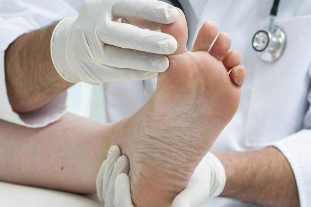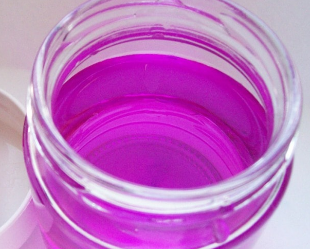Darkening of the nail plate, its thickening, delamination, and deformation can all be a sign of the development of nail fungus (onychomycosis). Many patients confuse an infected injuries or psoriasis. To prevent worsening of the disease, you need to know how to identify fungus on toe nails, its types and symptoms.
The types of fungus nails

Most often, a fungal infection spreads not only on the nail and affects about nail zone. Also suffers from the skin of the foot and interdigital folds as the hands and feet (athlete's foot). Among the most common pathogenic organisms that cause negative changes can be distinguished:
- the yeast – hit the nail, making it thinner, which leads to delamination of the plate from the bed;
- dermatophytes – penetrating into the stratum corneum, provoke the appearance of yellow bands or spots of white, which will eventually increase;
- mildew penetrates into the upper layers of the plate and changes its color to green, gray or black.
When the infection affects the nails, in the initial stages are already showing changes on the basis of which, we can distinguish 3 main types of fungus.
- Distal onychomycosis. Defeat starts from the edge of the stratum corneum, and then the infection moves to the base plate. The nail becomes greyish, thickens or thins, crumble and eventually almost completely destroyed.
- Proximal fungal. Extends from the center of the plate, causing the darkening and destruction.
- Superficial onychomycosis. Accompanied by the appearance of white spots in the center of the nail, or at its edges. Early in the disease plate has no deformations, but to the touch noticeable looseness that eventually leads to a change of the bed and loss of the nail.
The first signs and symptoms of nail fungus
The development of fungus no hidden flows. A few days after infection the first signs and symptoms which will eventually become brighter.
- The nail grows dull, loses its luster, changing the pattern plates appear yellow or white spots, longitudinal stripes.
- Changing the shape of the nail, is its deformation, which is accompanied by a thickening or thinning of the stratum corneum. This condition leads to delamination, attrition plate, and further separate it from the bed.
- Experiencing pain when pressed. The stratum corneum and the surrounding tissue become inflamed.
- Diaper rash between the toes, and odor from the affected nails.

These symptoms and signs help to identify a nail fungus in its early stages and to distinguish it from other diseases (bruises, psoriasis, eczema, lichen).
Diagnostic methods
The procedure of detection of onychomycosis or the fungal infection usually goes through several stages, which include specific methods: the clinical picture, microscopy.
Initially, the expert drew attention to the symptoms and complaints of the patient, gathering clinical data. After inspection of the nail plate and the skin around them a doctor prior identification of the infection, while excluding similar diseases (psoriasis, red shingles, problems with the normal diet of nails).
For confirmation of the disease the specialist makes the material to conduct microscopic examination. Of the affected area takes a scraping of tissue in laboratory conditions is treated with a special substance.
More accurately diagnose fungal property helps in the study of biological material. The analysis is carried out after the microscopy. Sowing is done scraping. A sample of the affected tissue is placed in a nutrient for fungus environment. After 3-5 days you can receive the results of the procedure. The type of fungus manages to learn the structure of the colonies, their peculiar growth and specific color.
Thanks to biological research accurately determine the type of the virus and its sensitivity to specific antimicrobials. It allows not only to identify the exact pathogen, but also to select an effective treatment.
How to identify nail fungus at home?
Darkening of the nail plate, its porosity and the depletion may not always indicate onychomycosis. To find out whether a fungal infection you can use the iodine and potassium permanganate.
Define onychomycosis by potassium permanganate
The procedure for the identification of the fungus takes little time and is easy to implement. In a basin of warm water to dissolve some manganese to make a weak solution. Put liquid hand or foot, wait for 5-10 minutes. During this time, healthy nails will be painted in brown color, the affected areas will remain unchanged.
Identifying nail fungus with iodine
Unlike manganese, iodine may not indicate the presence of pathogens of onychomycosis. Helps to exclude other fungi, particularly tinea versicolor. If the skin around the nail appeared peeling, redness, should such zones be treated with iodine. Healthy skin is almost dark under the alcoholic solution, but depriving the affected places will be a rich, dark color.
How to distinguish a fungal infection of the nails from other diseases?
In the first stages of development of fungal infection can be confused with skin diseases (psoriasis, shingles) or trauma of the nail. To not run negative manifestations, it is important to know the main differences of the fungal growth.

- Darkening of the nail plate, the appearance of yellow spots and longitudinal stripes, which eventually become larger and penetrate deeper into the nail.
- The smooth progression of the disease without exacerbations and calm, as is the case in psoriasis. The fungus gradually deforms the nail plate until its detachment from the bed.
- Odor and painful sensations, also distinguishes a fungus from injuries or psoriatic lesions, eczema, lichen.
- Causes of fungus can be access to the public areas (pool, sauna), wearing tight shoes (microtrauma and fading), increased sweating feet, diaper rash, and contact with an infected person.
- The fungus initially appears on one particular finger, often large, then it affects the rest of the phalanges and interdigital areas.
These differences help to identify the fungus in the early stages of its development. The main thing is to understand that self-diagnosis is not enough. For effective treatment you need examination by a specialist.
Mycosis – a nasty and insidious disease that can masquerade as other pathologies (psoriasis, eczema). It is important to monitor closely the nails and feet, and when suspicious symptoms in time to see a doctor for timely treatment.





























